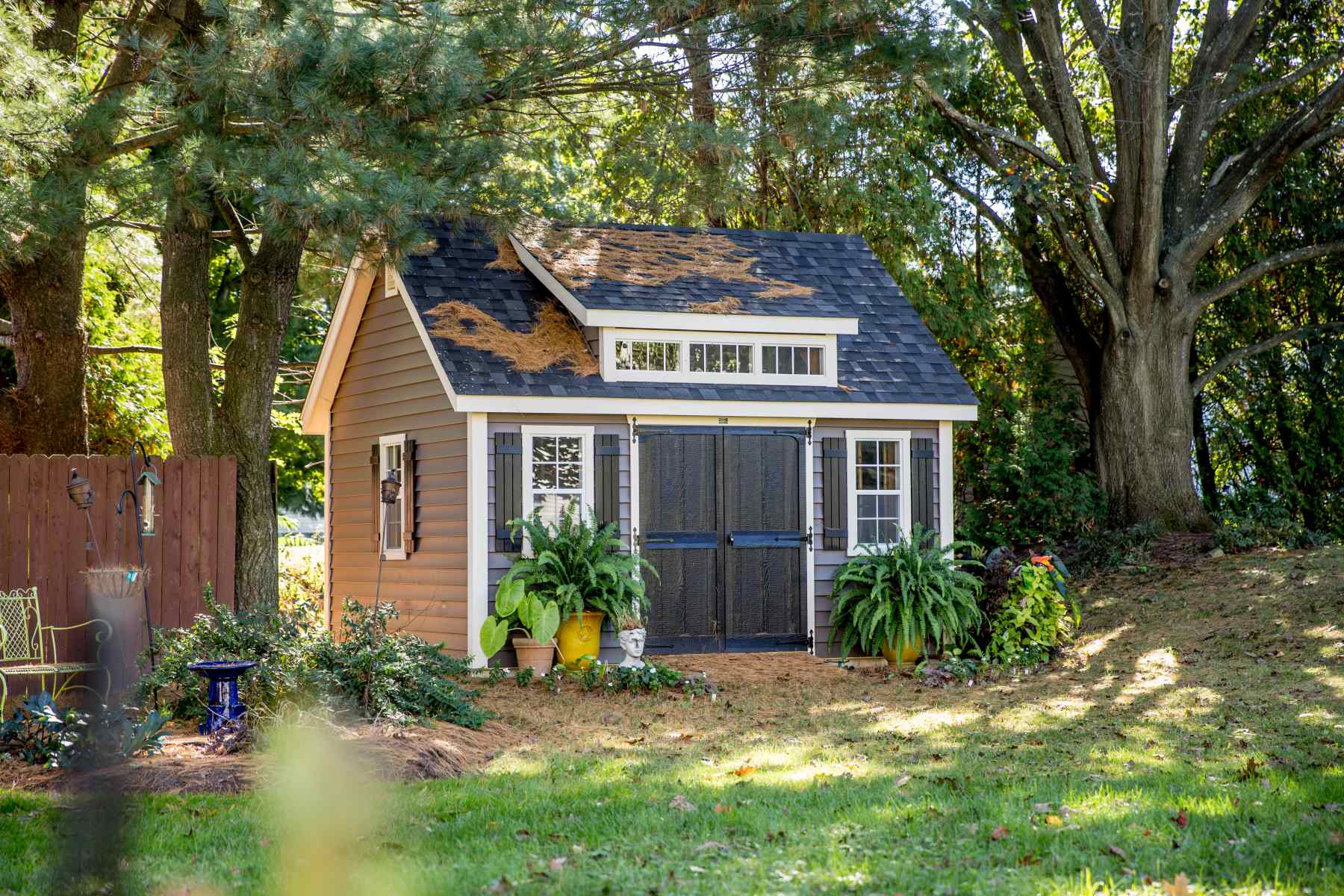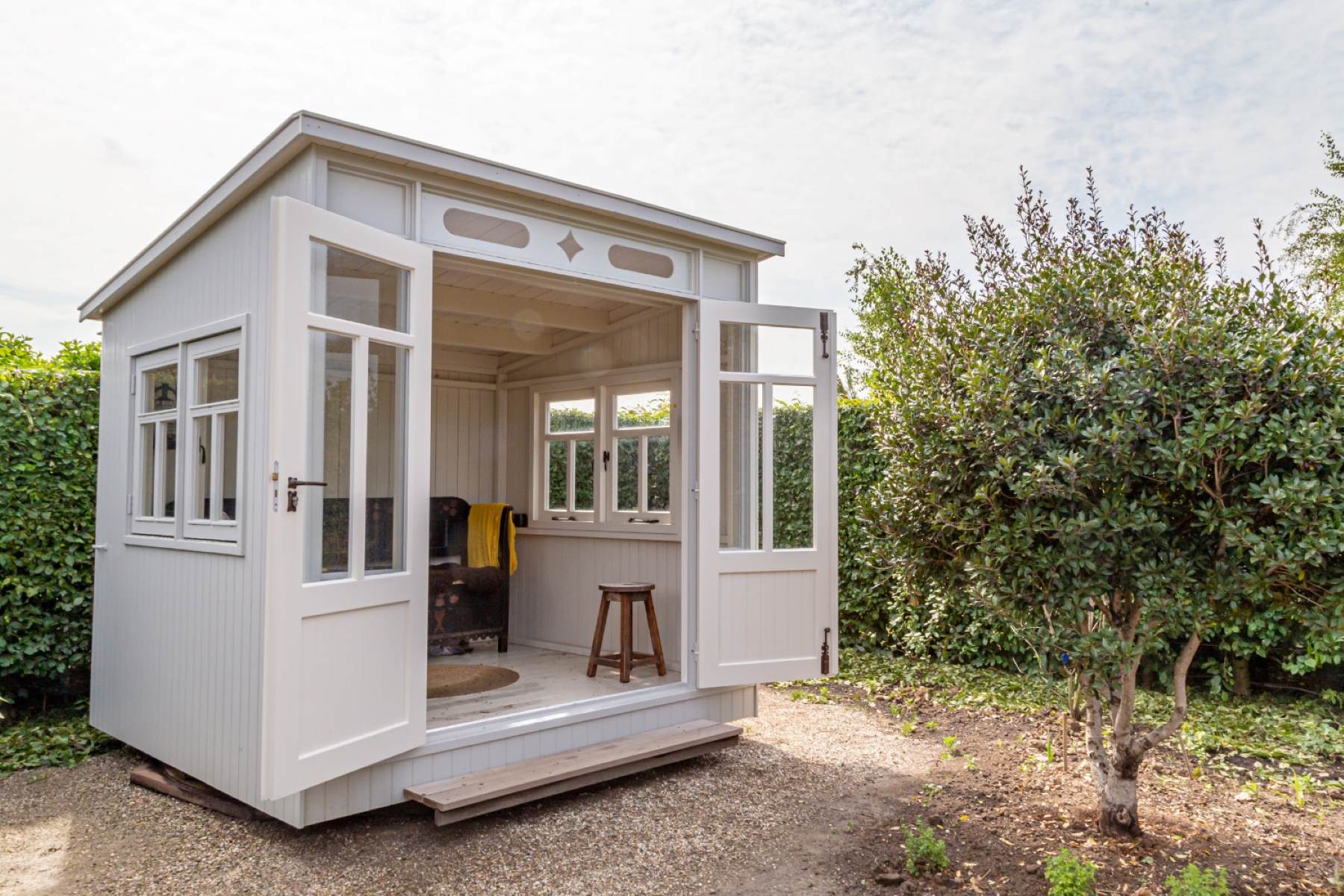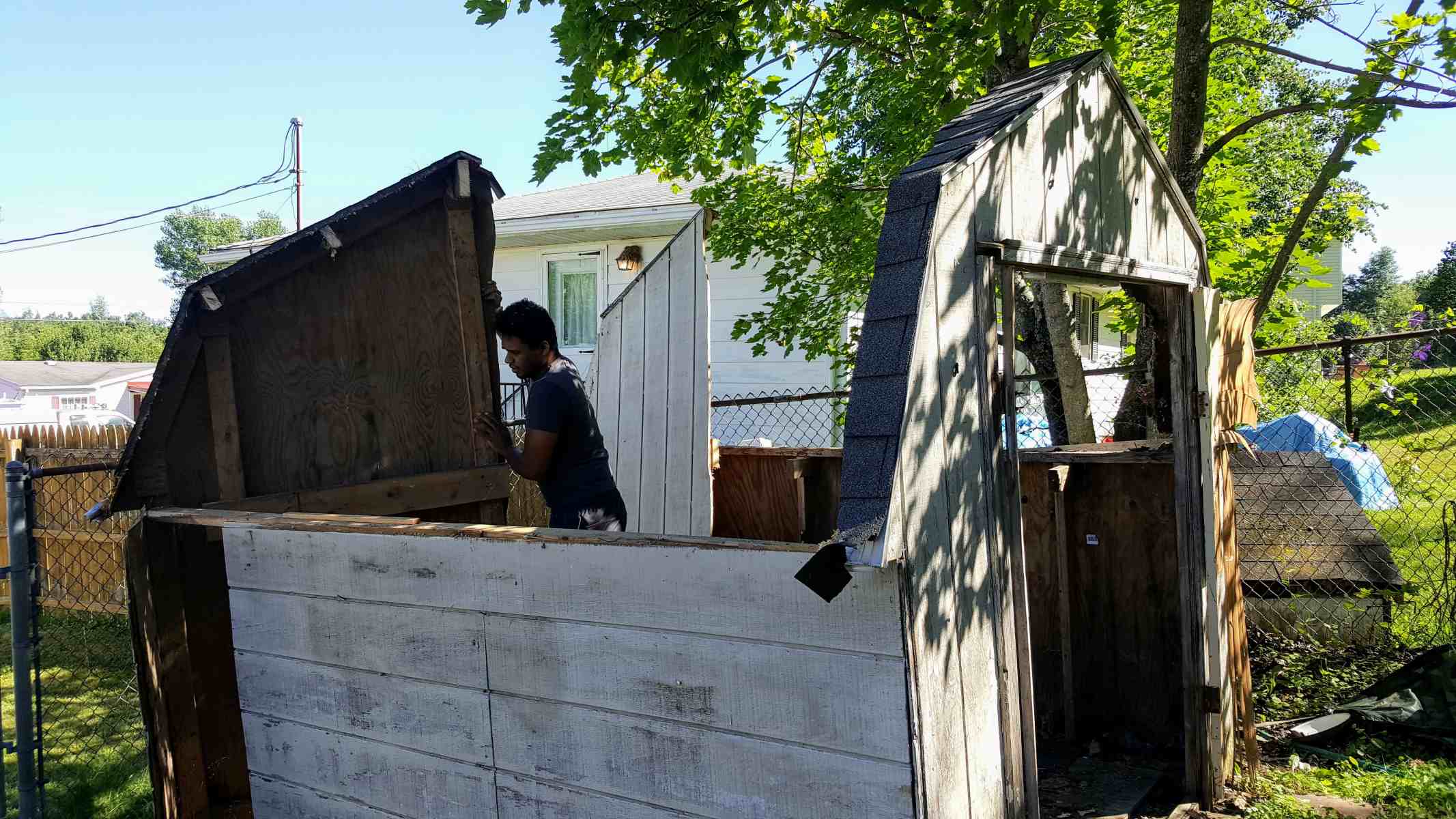Home>Home and Garden>The Ultimate Guide To Building Stunning Barns And Large Sheds – Unleash Your Inner Craftsman!


Home and Garden
The Ultimate Guide To Building Stunning Barns And Large Sheds – Unleash Your Inner Craftsman!
Published: February 15, 2024
Discover how to build beautiful barns and large sheds with our ultimate guide. Unleash your inner craftsman and transform your home and garden today!
(Many of the links in this article redirect to a specific reviewed product. Your purchase of these products through affiliate links helps to generate commission for Regretless.com, at no extra cost. Learn more)
Table of Contents
Introduction
Welcome to the ultimate guide to building stunning barns and large sheds! Whether you're a seasoned craftsman or a DIY enthusiast, embarking on a project to construct a barn or large shed is an exciting and rewarding endeavor. These versatile structures serve a multitude of purposes, from housing livestock and storing farm equipment to providing ample space for woodworking, crafting, and other hobbies. With careful planning, the right materials, and a dash of creativity, you can transform your vision into a functional and visually captivating addition to your property.
In this comprehensive guide, we'll delve into every aspect of building barns and large sheds, providing you with valuable insights, expert tips, and step-by-step instructions to help you unleash your inner craftsman. From the initial planning and design phase to the finishing touches and ongoing maintenance, we've got you covered. Whether you're aiming to create a rustic and charming barn or a modern and spacious large shed, this guide will equip you with the knowledge and inspiration needed to bring your project to life.
Throughout this guide, we'll explore the crucial considerations when planning and designing your structure, the diverse array of materials available for construction, and the essential steps for foundation preparation, framing, roofing, and siding installation. Additionally, we'll delve into the exciting realm of customization and finishing touches, empowering you to add unique features and personal flair to your barn or large shed. Moreover, we'll provide practical advice on maintaining and preserving your structure for long-lasting durability and functionality.
Whether you're envisioning a classic red barn nestled in a picturesque countryside setting or a spacious large shed with ample natural light and modern amenities, this guide will inspire you to embark on a fulfilling and transformative building journey. So, roll up your sleeves, dust off your tool kit, and let's dive into the world of building stunning barns and large sheds!
Planning and Designing Your Barn or Large Shed
When embarking on the journey of building a barn or large shed, meticulous planning and thoughtful design are the cornerstones of a successful project. Before picking up the hammer and nails, take the time to envision the purpose and functionality of your structure. Consider the intended use, whether it's for storing farm equipment, housing livestock, or serving as a workshop or storage space. Understanding the primary function of the barn or large shed will guide the design process and ensure that the end result meets your specific needs.
Next, consider the size and layout of the structure. Take into account the available space on your property and any zoning or building code regulations that may apply. Sketch out a rough floor plan, allocating areas for different purposes such as storage, workspace, and livestock accommodation. Pay attention to the flow of the space and how different areas will interact with one another. Additionally, consider the aesthetic elements of the design, such as the architectural style, exterior finish, and any decorative features you wish to incorporate.
Another crucial aspect of the planning phase is determining the materials to be used. Wood, metal, and vinyl are popular choices for barn and large shed construction, each offering unique advantages in terms of durability, cost, and aesthetic appeal. Consider the climate and environmental factors in your area when selecting materials, ensuring that they can withstand the elements and provide adequate insulation.
Furthermore, don't overlook the importance of natural light and ventilation. Incorporating windows, skylights, and ventilation systems into your design will not only enhance the comfort of the interior space but also contribute to energy efficiency and overall functionality.
In addition to the physical attributes of the structure, consider the surrounding landscape and how the barn or large shed will integrate with its environment. Pay attention to factors such as drainage, access roads, and proximity to other buildings or property boundaries. A well-integrated design will enhance the overall aesthetic appeal and functionality of the structure.
By carefully considering these aspects during the planning and design phase, you'll lay a solid foundation for the construction of a barn or large shed that not only meets your practical needs but also reflects your personal style and creativity. With a clear vision and thoughtful planning, you're ready to move on to the next exciting phase of bringing your project to life.
Choosing the Right Materials
Selecting the appropriate materials is a pivotal step in the construction of a barn or large shed, as it directly impacts the structure's durability, aesthetics, and functionality. When it comes to choosing the right materials, several factors should be taken into consideration to ensure that the end result meets both practical and aesthetic requirements.
Wood: Timeless Charm and Versatility
Wood remains a popular choice for barn and large shed construction, prized for its timeless charm and versatility. When opting for wood, consider the durability and resistance of the species to rot, insects, and weathering. Cedar, redwood, and pressure-treated lumber are favored for their natural resistance to decay, making them ideal for exterior applications. Additionally, the visual appeal of wood adds a rustic and inviting character to the structure, blending seamlessly with natural surroundings.
Metal: Strength and Low Maintenance
For those seeking a durable and low-maintenance option, metal materials such as steel or aluminum offer exceptional strength and longevity. Metal roofing and siding provide robust protection against harsh weather conditions, including heavy snow, strong winds, and intense sunlight. Furthermore, metal materials are fire-resistant and require minimal upkeep, making them a practical choice for long-term durability.
Vinyl: Durability and Ease of Maintenance
Vinyl has gained popularity in the construction of barns and large sheds due to its exceptional durability and ease of maintenance. Available in a variety of colors and textures, vinyl siding offers excellent resistance to moisture, fading, and pests. Its low maintenance requirements make it an attractive option for those seeking a long-lasting and visually appealing exterior finish.
Consider Climate and Environmental Factors
When selecting materials, it's crucial to consider the climate and environmental factors specific to your location. For areas prone to high humidity or extreme temperature fluctuations, materials with superior moisture resistance and thermal insulation properties are essential. Additionally, materials should be chosen based on their ability to withstand the local climate, ensuring that the structure remains resilient and functional for years to come.
Balancing Cost and Long-Term Value
While cost considerations are important, it's essential to strike a balance between upfront expenses and long-term value. Investing in high-quality materials that offer superior durability and longevity can result in significant savings on maintenance and replacement costs over the structure's lifespan.
By carefully evaluating the characteristics and benefits of different materials, you can make informed decisions that align with your specific needs and preferences. The right materials will not only ensure the structural integrity and longevity of your barn or large shed but also contribute to its visual appeal and overall functionality.
Foundation and Site Preparation
The foundation and site preparation phase is a critical precursor to the construction of a barn or large shed, laying the groundwork for a sturdy, level, and long-lasting structure. Proper planning and execution during this stage are essential to ensure the structural integrity and stability of the building, as well as its resilience against environmental factors.
Site Selection and Clearing
Before commencing any groundwork, careful consideration must be given to site selection. Choose a location that offers good drainage, minimal risk of flooding, and optimal sunlight exposure. Clear the chosen site of any vegetation, debris, or obstructions, ensuring a clean and level surface for the foundation.
Excavation and Grading
Excavation is the next crucial step, involving the removal of topsoil and the creation of a level surface for the foundation. Proper grading of the site is essential to ensure water drainage away from the structure, preventing potential water accumulation and damage. The use of surveying tools and equipment is recommended to achieve precise grading and ensure uniform support for the foundation.
Foundation Construction
The foundation serves as the anchor for the entire structure, providing stability and load-bearing support. Depending on the soil composition and local building codes, various foundation types may be suitable, including concrete slabs, pier and beam foundations, or concrete footings. Each foundation type has its own requirements for excavation depth, reinforcement, and concrete pouring, necessitating adherence to local regulations and engineering standards.
Consideration for Climate and Soil Conditions
Climate and soil conditions play a significant role in determining the appropriate foundation design. In regions prone to frost heave, deep footings or insulated concrete slabs may be necessary to prevent ground movement during freezing and thawing cycles. Similarly, soil composition, such as expansive clay or loose sand, requires tailored foundation solutions to mitigate potential settling or shifting of the structure over time.
Utility Installation and Access Planning
During the site preparation phase, it's essential to consider the installation of utilities such as electrical wiring, plumbing, and drainage systems. Additionally, planning for access roads, pathways, and parking areas should be integrated into the site layout to ensure convenient and practical use of the barn or large shed.
Environmental Compliance and Permits
Adherence to environmental regulations and obtaining necessary permits are fundamental aspects of site preparation. Compliance with local zoning laws, environmental impact assessments, and building permits is essential to avoid potential legal issues and ensure the project's conformity to regulatory standards.
By meticulously addressing the foundation and site preparation requirements, you establish a solid groundwork for the subsequent stages of construction, setting the stage for the realization of a structurally sound and functional barn or large shed. The attention to detail and precision during this phase will contribute to the overall longevity and resilience of the completed structure.
Framing and Construction
The framing and construction phase marks a pivotal stage in the realization of a barn or large shed, where the structural framework takes shape, defining the form and strength of the building. This phase encompasses a series of precise tasks, from erecting the skeletal framework to installing sheathing, doors, and windows, culminating in the creation of a robust and functional structure.
Structural Framework
The first step in framing involves the assembly of the structural framework, typically constructed from wood or metal components. The framework serves as the skeleton of the building, providing support for the walls, roof, and overall structural integrity. Depending on the design and intended use of the structure, the framing may consist of traditional wood studs, engineered trusses, or steel framing systems. Careful attention to precise measurements and alignment is crucial to ensure the structural integrity and squareness of the framework.
Wall Construction
With the framework in place, the construction of exterior and interior walls commences. Exterior walls are typically sheathed with plywood or oriented strand board (OSB) to provide lateral stability and a base for siding installation. Interior walls are framed and insulated to define functional spaces within the structure. The incorporation of insulation materials contributes to energy efficiency and climate control within the building.
Roofing Installation
The installation of the roof system is a significant aspect of the construction phase, requiring meticulous attention to detail and weatherproofing. Depending on the design, roofing materials such as asphalt shingles, metal panels, or composite roofing may be employed. Proper roof ventilation and flashing installation are essential to prevent moisture buildup and ensure long-term durability.
Door and Window Placement
The addition of doors and windows brings functionality and aesthetic appeal to the structure. Careful placement and installation of doors for entry and access, as well as windows for natural light and ventilation, are integral to the overall design. Proper sealing and weatherproofing around door and window openings are crucial to prevent air and water infiltration.
Structural Integrity and Safety
Throughout the framing and construction phase, adherence to building codes and structural engineering standards is paramount. Ensuring the structural integrity and safety of the building through proper fastening, bracing, and load-bearing considerations is fundamental to the long-term performance and stability of the structure.
Progress and Precision
The framing and construction phase requires a balance of progress and precision, as each component and connection contributes to the overall strength and functionality of the building. Diligent craftsmanship, attention to detail, and adherence to best practices are essential to achieve a well-constructed and enduring barn or large shed.
As the framing and construction phase nears completion, the structure begins to take on its intended form, reflecting the vision and craftsmanship invested in its creation. The successful execution of this phase sets the stage for the subsequent stages of finishing touches and customization, bringing the project closer to its ultimate realization.
Roofing and Siding Installation
Roofing and siding installation is a crucial phase in the construction of a barn or large shed, representing the culmination of the structural framework and the commencement of weatherproofing and exterior finishing. This phase encompasses a series of meticulous tasks, from selecting appropriate roofing materials to ensuring proper installation techniques, ultimately contributing to the durability, functionality, and visual appeal of the structure.
Selecting Roofing Materials
The selection of roofing materials plays a pivotal role in determining the performance and aesthetic attributes of the structure. Common roofing options for barns and large sheds include asphalt shingles, metal roofing panels, and composite roofing materials. Each material offers unique benefits in terms of durability, weather resistance, and visual appeal. Consideration should be given to the climate and environmental factors specific to the building's location, ensuring that the chosen roofing material can withstand the elements and provide long-term protection.
Weatherproofing and Insulation
Proper weatherproofing and insulation are essential components of roofing installation, contributing to energy efficiency and climate control within the structure. The installation of underlayment, such as roofing felt or synthetic materials, provides an additional layer of protection against moisture infiltration and acts as a barrier against wind-driven rain. Moreover, the incorporation of insulation materials within the roofing system enhances thermal performance, contributing to a comfortable interior environment and reduced energy consumption.
Siding Installation Techniques
The installation of siding is a critical aspect of the exterior finishing, serving as a protective and decorative layer for the building. Common siding materials include wood, vinyl, metal, and composite options, each offering distinct advantages in terms of durability, maintenance, and visual appeal. Proper installation techniques, including the use of flashing, caulking, and fastening methods, are essential to ensure a weather-tight and visually appealing exterior finish.
Aesthetic Considerations
In addition to functionality and durability, aesthetic considerations play a significant role in the selection and installation of roofing and siding materials. The choice of colors, textures, and profiles can dramatically impact the visual appeal of the structure, complementing its surroundings and reflecting the desired architectural style. Furthermore, the integration of architectural details such as gables, dormers, and trim elements adds character and charm to the exterior, enhancing the overall aesthetic impact of the building.
Quality Craftsmanship
The successful installation of roofing and siding requires precision, attention to detail, and adherence to best practices. Proper fastening, alignment, and weatherproofing techniques are fundamental to the long-term performance and resilience of the exterior envelope. Quality craftsmanship and meticulous execution during this phase contribute to the overall integrity and visual impact of the barn or large shed.
The Final Touches
As the roofing and siding installation phase nears completion, the structure begins to take on its finalized form, showcasing the careful selection and expert installation of materials. The successful execution of this phase sets the stage for the subsequent stages of finishing touches and customization, bringing the project closer to its ultimate realization.
By meticulously addressing the roofing and siding installation requirements, you ensure the long-term durability, weather resistance, and visual appeal of your barn or large shed, setting the stage for a functional and aesthetically pleasing structure.
Finishing Touches and Customization
The finishing touches and customization phase of building a barn or large shed represents the culmination of the construction journey, where attention to detail, creativity, and personalization elevate the structure from functional to exceptional. This phase offers the opportunity to infuse the building with unique character, tailored to individual preferences and practical needs.
Exterior and Interior Detailing
The exterior detailing of the structure encompasses a wide range of aesthetic and functional elements, including trim work, decorative accents, and architectural embellishments. Gable and eave detailing, window trim, and door surrounds contribute to the visual appeal of the building, adding depth and character to the exterior facade. Additionally, the incorporation of cupolas, weathervanes, and exterior lighting fixtures enhances the architectural charm and creates a distinctive presence.
Internally, the customization of interior spaces allows for tailored functionality and personalization. From storage solutions and workbenches to specialized areas for hobbies or livestock care, the interior detailing reflects the specific needs and preferences of the owner. Thoughtful consideration of lighting, ventilation, and interior finishes contributes to a comfortable and inviting environment within the structure.
Custom Features and Additions
Custom features and additions provide the opportunity to enhance the functionality and visual appeal of the barn or large shed. This may include the installation of custom-built doors and windows, the addition of skylights for natural illumination, or the integration of specialized equipment or amenities. Moreover, the incorporation of porches, overhangs, and covered storage areas extends the utility of the structure while creating inviting outdoor spaces.
Personalization and Aesthetic Appeal
The personalization of the structure through color schemes, exterior finishes, and landscaping integration allows for a cohesive and harmonious integration with the surrounding environment. Whether aiming for a traditional, rustic aesthetic or a modern, sleek appearance, the customization phase enables the expression of individual style and taste. Landscaping elements such as garden beds, pathways, and fencing further enhance the visual impact of the structure, creating a cohesive and inviting property.
Functional Upgrades and Specialized Spaces
Functional upgrades and specialized spaces cater to specific needs and hobbies, transforming the barn or large shed into a versatile and accommodating space. This may include the installation of climate control systems, electrical outlets, or plumbing for convenience and comfort. Specialized spaces for woodworking, crafting, or vehicle maintenance can be tailored to facilitate efficient and enjoyable pursuits.
Long-Term Vision and Adaptability
The customization phase also allows for consideration of long-term vision and adaptability, ensuring that the structure can evolve with changing needs and preferences. Thoughtful design and customization enable the building to serve as a flexible and enduring asset, capable of accommodating future uses and activities.
In essence, the finishing touches and customization phase represents the opportunity to transform a functional structure into a personalized and captivating space. Through attention to detail, creativity, and practical considerations, the barn or large shed becomes a reflection of individual style, functionality, and long-term vision.
Maintenance and Upkeep
Ensuring the long-term durability and functionality of a barn or large shed requires a proactive approach to maintenance and upkeep. By implementing regular maintenance practices and addressing potential issues in a timely manner, you can preserve the structural integrity and aesthetic appeal of the building for years to come.
Inspections and Repairs
Regular inspections are essential to identify and address any signs of wear, damage, or deterioration. Inspect the roofing, siding, and structural components for signs of water infiltration, pest infestation, or structural movement. Promptly address any issues by conducting necessary repairs, such as replacing damaged roofing materials, repairing siding, or reinforcing structural elements. Additionally, inspect doors, windows, and hardware for proper operation and weatherproofing.
Exterior Maintenance
The exterior of the barn or large shed requires ongoing maintenance to protect it from the elements. Periodically clean the exterior surfaces to remove dirt, debris, and organic growth. Check and maintain the integrity of the siding, ensuring that it remains securely fastened and free from damage. Attend to any areas of peeling paint or finish to prevent moisture intrusion and maintain the visual appeal of the structure.
Roof and Gutters
Regularly inspect the roof for damaged or missing shingles, as well as signs of deterioration in flashing and sealants. Clean gutters and downspouts to ensure proper water drainage and prevent water accumulation on the roof or around the foundation. Address any issues with the roof or gutters promptly to prevent water damage and potential structural issues.
Pest Control
Implement measures to prevent pest infestation, such as sealing potential entry points, storing organic materials away from the structure, and maintaining a clean and clutter-free environment. Consider the use of pest-resistant materials and periodic inspections to detect and address any signs of pest activity.
Structural Integrity
Maintain the structural integrity of the building by addressing any signs of movement, settlement, or deterioration. Ensure that the foundation remains stable and free from cracks or shifting. Attend to any structural repairs promptly to prevent further damage and maintain the safety of the building.
Interior Care
If the barn or large shed includes interior spaces, such as workshops or storage areas, implement regular cleaning and organization practices to maintain a functional and safe environment. Attend to any signs of water infiltration or humidity to prevent mold growth and deterioration of stored items.
Seasonal Considerations
Adapt maintenance practices to seasonal changes, such as preparing the structure for winter weather by ensuring proper insulation, addressing potential ice dams, and protecting exterior surfaces from harsh conditions. In warmer months, focus on ventilation, pest control, and landscaping maintenance to preserve the exterior and interior environments.
By prioritizing regular maintenance and proactive upkeep, you can extend the lifespan and functionality of your barn or large shed, ensuring that it continues to serve its intended purpose and remains a valuable asset on your property.
Conclusion
In conclusion, the journey of building a stunning barn or large shed is a fulfilling and transformative endeavor that combines craftsmanship, creativity, and practicality. From the initial stages of planning and design to the meticulous execution of construction and finishing touches, every phase of the process contributes to the creation of a functional and visually captivating structure.
The planning and design phase sets the stage for the entire project, allowing for careful consideration of the structure's purpose, layout, and aesthetic elements. This phase provides the opportunity to envision a space that seamlessly integrates with its surroundings while meeting specific functional needs.
Selecting the right materials and preparing the site with a solid foundation are crucial steps that ensure the durability and resilience of the structure. The choice of materials, construction techniques, and attention to environmental factors contribute to the long-term performance of the barn or large shed.
The framing and construction phase brings the vision to life, as the structural framework takes shape, defining the form and strength of the building. Attention to detail, precision, and adherence to building codes are essential during this phase to ensure the structural integrity and safety of the structure.
Roofing and siding installation represent the culmination of the structural framework and the commencement of weatherproofing and exterior finishing. The selection and installation of roofing and siding materials contribute to the durability, weather resistance, and visual appeal of the structure, setting the stage for the subsequent phases of finishing touches and customization.
The finishing touches and customization phase allow for the infusion of unique character and personalized functionality into the structure. Attention to exterior and interior detailing, custom features, and long-term adaptability ensure that the barn or large shed reflects individual style and practical needs.
Finally, the commitment to ongoing maintenance and upkeep ensures the longevity and functionality of the structure. Regular inspections, exterior maintenance, and seasonal considerations are essential to preserve the structural integrity and aesthetic appeal of the building.
In essence, the journey of building a stunning barn or large shed is a testament to creativity, craftsmanship, and practicality. Each phase of the process contributes to the realization of a space that not only serves its intended purpose but also stands as a reflection of individual style, functionality, and long-term vision.





